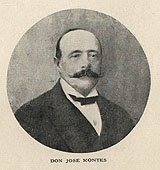| Martin | << = = | The Early Settlers of the Country José Montes |
= = >> | P. Montes |
 Born
in Ribera de Arriba, province of Oviedo, son of a farmer. When he was 17 years
of age, he came to Buenos Aires and worked on the land belonging to some Basques
at San Fernando. One day, he met a cousin of his, Don Mariano Montes, a doctor
of divinity who had given up the clerical profession, and they agreed to go
together to Punta Arenas which was ten a hamlet of 800 souls, most of them
exiles. Mr. Montes got immediate employment with the firm Braun (later Braun
and Skroder), where he remained as a clerk for eleven months.
Born
in Ribera de Arriba, province of Oviedo, son of a farmer. When he was 17 years
of age, he came to Buenos Aires and worked on the land belonging to some Basques
at San Fernando. One day, he met a cousin of his, Don Mariano Montes, a doctor
of divinity who had given up the clerical profession, and they agreed to go
together to Punta Arenas which was ten a hamlet of 800 souls, most of them
exiles. Mr. Montes got immediate employment with the firm Braun (later Braun
and Skroder), where he remained as a clerk for eleven months.
With his savings, plus one hundred gold pieces (Isabelinas), which his father had given him when leaving Spain, he bought some horses and devoted himself to selling to and buying from the Indians (Tehuelches), from Sandy Point to Coyle. He hired a schooner later to trade with the Indians of Santa Cruz, carrying occasional supplies to the Governor of that territory, Mr. Moyano. He purchased cattle and sheep, supplying the sub-prefect of Rio Gallegos with meat and other elementary necessities, payment of which often cost him more than an effort. Urged by his enterprising spirit, Montes took lands of the Argentine Government at Rio Gallegos, and others at the Coyle River. This was the time when the sturdy Spanish settler had the hardest struggle against the inclemency of the weather, the scourge of rain and wind sleeping on the black scrub in the creeks, roofless and shelterless. So passed eight or ten years. Wool was worth little about 4 to 6 Argentine pesos the 10 kilogrammes; meat went as low as three cents a kilo. But in spite of every adversity, Asturian pluck was not daunted, trusting blindly in a better time to come.
The setting-up of the first freezing establishments opened new prospects for the cattle business. And the wished for triumph came. Today, Don Jose Montes is one of the wealthiest men in the South, for he owns estancias in Gallegos, Coyle, Santa Cruz, Tierra del Fuego and in various parts of Chilian Patagonia.
Source: «La Patagonia Argentina», pp.150-151